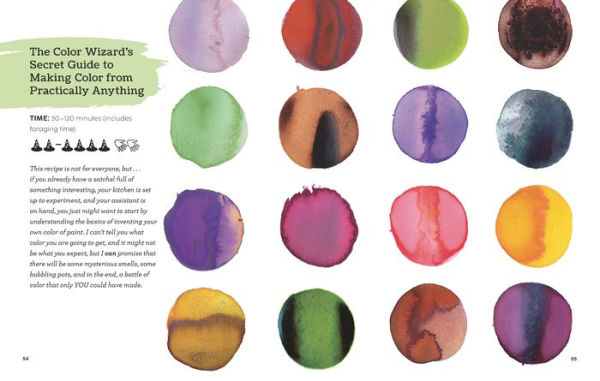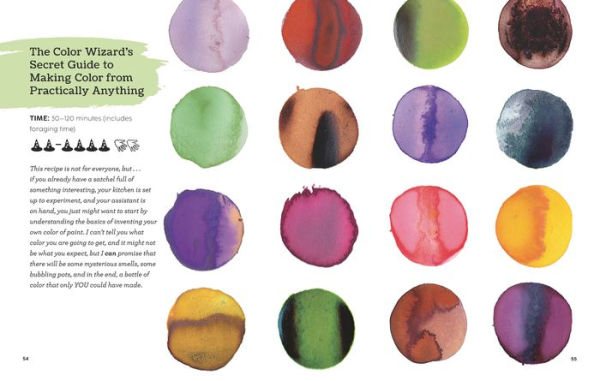How to Be a Color Wizard: Forage and Experiment with Natural Art Making
In a bountiful book combining art and chemistry, a celebrated ink maker invites kids to become color wizards—by foraging and transforming natural materials to make their own paint and artistic creations.
In this book you will find secret recipes, magic formulas, and wild experiments that will delight your friends, intimidate your enemies, and turn you into a color wizard.
What colors might await in a leafy forest, a berry-stained back alley, a seaweedy beach, or even the dark corners of an ordinary fridge? With this book as a guide, curious young wizards can make natural confetti, unlock the hidden color power inside a leaf, and craft a paintbrush wand. They’ll brew magic potions from beets and acorn caps to produce their own colors, from the darkest black to the palest pink to invisible ink, then share their discoveries with friends, family, and the whole color-hungry human race. With whimsy and infectious enthusiasm, master ink maker Jason Logan explains the science of color while presenting “quests,” recipes, and hands-on activities using materials kids can find in their own homes and neighborhoods. Featuring both photographs and the author’s own gorgeous homemade-ink illustrations, How to Be a Color Wizard is an ideal blend of art and science—plus a little bit of magic.
"1144455548"
In this book you will find secret recipes, magic formulas, and wild experiments that will delight your friends, intimidate your enemies, and turn you into a color wizard.
What colors might await in a leafy forest, a berry-stained back alley, a seaweedy beach, or even the dark corners of an ordinary fridge? With this book as a guide, curious young wizards can make natural confetti, unlock the hidden color power inside a leaf, and craft a paintbrush wand. They’ll brew magic potions from beets and acorn caps to produce their own colors, from the darkest black to the palest pink to invisible ink, then share their discoveries with friends, family, and the whole color-hungry human race. With whimsy and infectious enthusiasm, master ink maker Jason Logan explains the science of color while presenting “quests,” recipes, and hands-on activities using materials kids can find in their own homes and neighborhoods. Featuring both photographs and the author’s own gorgeous homemade-ink illustrations, How to Be a Color Wizard is an ideal blend of art and science—plus a little bit of magic.
How to Be a Color Wizard: Forage and Experiment with Natural Art Making
In a bountiful book combining art and chemistry, a celebrated ink maker invites kids to become color wizards—by foraging and transforming natural materials to make their own paint and artistic creations.
In this book you will find secret recipes, magic formulas, and wild experiments that will delight your friends, intimidate your enemies, and turn you into a color wizard.
What colors might await in a leafy forest, a berry-stained back alley, a seaweedy beach, or even the dark corners of an ordinary fridge? With this book as a guide, curious young wizards can make natural confetti, unlock the hidden color power inside a leaf, and craft a paintbrush wand. They’ll brew magic potions from beets and acorn caps to produce their own colors, from the darkest black to the palest pink to invisible ink, then share their discoveries with friends, family, and the whole color-hungry human race. With whimsy and infectious enthusiasm, master ink maker Jason Logan explains the science of color while presenting “quests,” recipes, and hands-on activities using materials kids can find in their own homes and neighborhoods. Featuring both photographs and the author’s own gorgeous homemade-ink illustrations, How to Be a Color Wizard is an ideal blend of art and science—plus a little bit of magic.
In this book you will find secret recipes, magic formulas, and wild experiments that will delight your friends, intimidate your enemies, and turn you into a color wizard.
What colors might await in a leafy forest, a berry-stained back alley, a seaweedy beach, or even the dark corners of an ordinary fridge? With this book as a guide, curious young wizards can make natural confetti, unlock the hidden color power inside a leaf, and craft a paintbrush wand. They’ll brew magic potions from beets and acorn caps to produce their own colors, from the darkest black to the palest pink to invisible ink, then share their discoveries with friends, family, and the whole color-hungry human race. With whimsy and infectious enthusiasm, master ink maker Jason Logan explains the science of color while presenting “quests,” recipes, and hands-on activities using materials kids can find in their own homes and neighborhoods. Featuring both photographs and the author’s own gorgeous homemade-ink illustrations, How to Be a Color Wizard is an ideal blend of art and science—plus a little bit of magic.
22.99
Pre Order
5
1

How to Be a Color Wizard: Forage and Experiment with Natural Art Making
176
How to Be a Color Wizard: Forage and Experiment with Natural Art Making
176Hardcover
$22.99
22.99
Pre Order

Product Details
| ISBN-13: | 9781536229400 |
|---|---|
| Publisher: | Candlewick Press |
| Publication date: | 09/10/2024 |
| Pages: | 176 |
| Sales rank: | 228,140 |
| Product dimensions: | 7.44(w) x 9.31(h) x 0.66(d) |
| Age Range: | 10 - 13 Years |
About the Author
From the B&N Reads Blog









